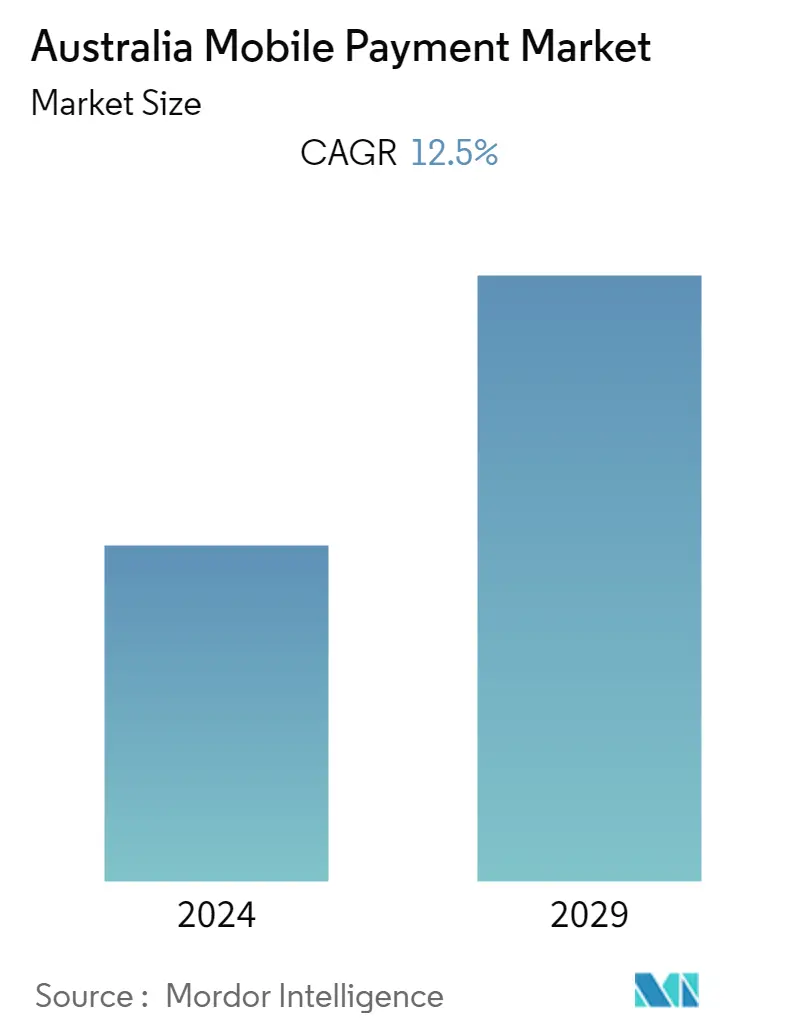Market Size of Australia Mobile Payment Industry

| Study Period | 2019 - 2029 |
| Base Year For Estimation | 2023 |
| Forecast Data Period | 2024 - 2029 |
| Historical Data Period | 2019 - 2022 |
| CAGR | 12.50 % |
| Market Concentration | Medium |
Major Players.webp)
*Disclaimer: Major Players sorted in no particular order |
Australia Mobile Payment Market Analysis
The Australian mobile payments market is expected to grow at a CAGR of 12.5% over the forecast period (2022 - 2027). The stores and services in Australia are rapidly adopting mobile payment applications, such as PayPal, Samsung Pay, and Apple Pay to accept and transfer payments. With increasing internet adoption and rapid growth in online retailing, this trend is expected to continue over the forecast period.
- The payment processing environment in Australia has changed dramatically in recent years. Because of the rising need for contactless payments, the usage of digital payment methods for direct payments has fueled the adoption of mobile payments.
- The increased use of smartphones in the country has enabled the development and use of mobile applications for various purposes. With the advancement of payment applications and technologies such as mobile payments, customers have an easy and seamless method to pay for online and in-store purchases, bill payments, money transfers, and many other things.
- Furthermore, mobile payments provide a simple and safe method of making transactions. Through tokenization, individuals can use mobile wallets to store credit and debit card information on their devices. This changes card numbers, rendering the data useless to hackers. According to a survey conducted by the Reserve Bank In 2021, the value of credit card payments made in Australia amounted to around AUD 310.5 billion. The value of debit card payments amounted to AUD 417.9 billion in the same year.
- However, data privacy remains a major threat to mobile phone applications that provide mobile wallets. Companies are continuously working to introduce simpler and safer methods of authenticating their clients' identities, increasing their policies' safety and dependability.
- To prevent the spread of the Covid-19 pandemic, the need for contactless payments in retail stores such as grocery stores and restaurants has increased. Because there is no touch involved in the payment process, contactless payment solutions provided by mobile wallets are a secure alternative to dealing with cash and traditional credit cards.
Australia Mobile Payment Industry Segmentation
Mobile payments help automate payment processes by providing an alternative mode of payment via a portable electronic device such as a smartphone or tablet. Mobile payments can also make digital financial transfers rather than paying with a check or cash. Mobile payment technology has many applications in industries such as movie tickets, restaurants, and retail stores. The market tracks the transaction volume of mobile payments made in Australia. Australia Mobile Payment Market is Segmented By Type (Proximity and Remote).
| By Type (Market share in percentage based on relative adoption) | |
| Proximity | |
| Remote |
Australia Mobile Payment Market Size Summary
The Australian mobile payments market is experiencing significant growth, driven by the rapid adoption of digital payment applications like PayPal, Samsung Pay, and Apple Pay. This trend is fueled by increasing internet penetration and the expansion of online retailing, which have transformed the payment processing landscape. The demand for contactless payment solutions has surged, particularly in the wake of the Covid-19 pandemic, as consumers seek safe and convenient alternatives to cash and traditional credit cards. The proliferation of smartphones and high-speed cellular networks has further accelerated the adoption of mobile payments, enabling seamless transactions for online and in-store purchases, bill payments, and money transfers. Despite concerns over data privacy, advancements in security technologies such as tokenization, AI, ML, and biometric authentication are enhancing the safety and reliability of mobile payment systems.
The market is characterized by intense competition, with numerous companies offering innovative mobile payment solutions. Telecom operators and financial service providers are actively entering the space, integrating payment capabilities into existing apps and developing new offerings. The e-commerce sector's growth is a significant contributor to the mobile payments market's expansion, as more consumers embrace mobile wallets and digital banking tools. Australian consumers are leading the way in mobile wallet adoption, with a high level of trust in these technologies. Partnerships and collaborations, such as those between Westpac and Airpay, and P97 Networks and Viva Energy Australia, are further driving the market's development. As the market continues to evolve, companies are focusing on enhancing payment security and user experience to maintain their competitive edge.
Australia Mobile Payment Market Size - Table of Contents
-
1. MARKET DYNAMICS
-
1.1 Market Drivers
-
1.1.1 Growing Awareness for E-Wallet and E-Commerce to Drive the Market
-
1.1.2 Development of M-Commerce Platforms and Increasing Internet Penetration
-
-
1.2 Market Challenges
-
1.2.1 Security Issues Associated with Mobile Payments
-
-
1.3 Analysis on Enabling Technologies (Coverage to include NFC, QR, etc.)
-
1.4 Key Regulations and Standards in the Mobile Payments Industry
-
-
2. MARKET SEGMENTATION
-
2.1 By Type (Market share in percentage based on relative adoption)
-
2.1.1 Proximity
-
2.1.2 Remote
-
-
Australia Mobile Payment Market Size FAQs
What is the current Australia Mobile Payment Market size?
The Australia Mobile Payment Market is projected to register a CAGR of 12.5% during the forecast period (2024-2029)
Who are the key players in Australia Mobile Payment Market?
Apple Inc. (Apple Pay), Paypal Inc.(Paypal), Google LLC(Google Pay), Afterpay Limited (Block, Inc.) and Commonwealth Bank of Australia (CommBank Tap & Pay) are the major companies operating in the Australia Mobile Payment Market.

